Flash Silvermoon: Spiritual Renaissance Feminist
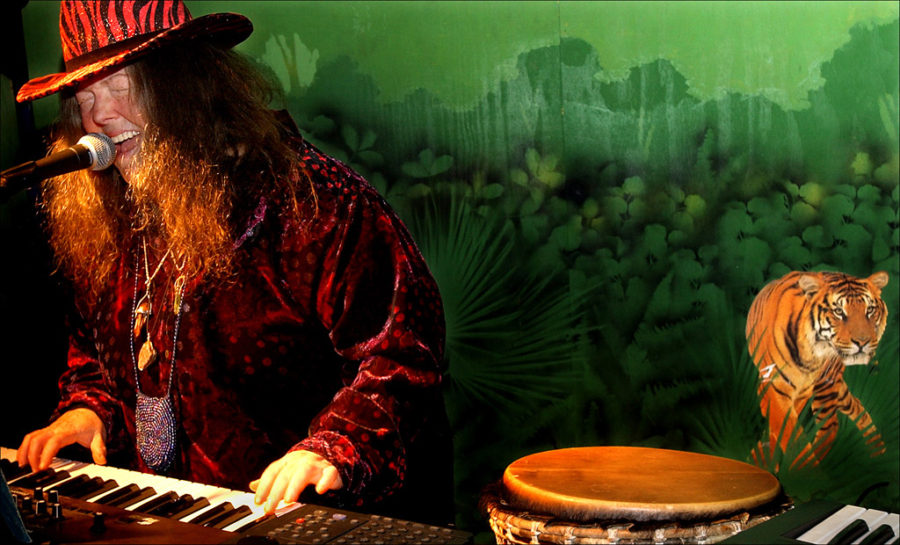
Interview by Rose Norman on November 12, 2012.
Rose Norman: This is Rose Norman, and I’m here with Flash Silvermoon and Pandora Lightmoon, in Flash’s home in Melrose, Florida. It’s November 12, 2012, and she’s here to be interviewed for the Southern Lesbian Feminist Activist Herstory Project. We’ll start with a question about how you became a feminist activist.
Flash Silvermoon: OK. Well, I came by it naturally, I’ll have to say. In kindergarten, I was confronted with the fact that girls weren’t supposed to play drums. I had waited my turn patiently through the rhythm line of all the little rhythm instruments that are supposed to be fun, and I bored myself with these instruments waiting for my special moment to play the snare drum. When it was my turn, I was so excited I could hardly sleep. I put the drum on, and I was told, “No, girls don’t play the drums.” I was shocked, because that is not how I was raised, even back then. I told the teacher that’s not fair and can I do something else, because I really didn’t want to continue in something that was so wrong. She said, “well, you can paint.” I said, all right, and I fingerpainted in a corner for the whole rest of the school year, not happily, but proud that I wasn’t working a game I couldn’t win in. The whole thing with drums went all through high school. The band teacher, when he saw me, said, “Oh, you’re going to play the piano” and I said, “No, I want to play the drums.” He said, “You play the piano good!” I said, “Yeah, but I want to play the drums.” And he said, “No girls in the percussion section.”
On to high school. I’m thinking, I can’t carry a piano in the marching band. And they moved that little bigot teacher into the high school. I was horrified when I saw him moved into the next level of music possibilities. So he wouldn’t let me play except when no one else came and they really needed a drummer, because I was better than the boys. So I got to play occasionally when no one else would, like if it was raining.
Biographical Note
Flash Silvermoon, born in 1950 and died in 2017, was named at birth Deborah Kotler. She grew up Jewish in Bayonne, New Jersey. After attending college in Trenton, New Jersey, she moved to New York City. She stirred up New York until she was enticed to move to Melrose, Florida, in 1975, where she lived until her death in 2017.
Flash Silvermoon always had the seed of feminism. Her feminism and her love of music began in kindergarten, when she rebelled at being told that girls don’t play the snare drum. This rebellion nurtured her ensuing activism, which continued through high school and college, blossoming as a life-long exploit.
College
This continued until college. I thought, “Ah, I’m entering as a piano major, percussion minor!” and it was done. Finally, a realized ambition, except that the music department was way too narrow for me, and they kept telling me that I was wrong and I shouldn’t be there, and that there was no room for people playing my music. I was playing the Beatles, improvising with rock and jazz, and they told me that they didn’t want me playing in the practice rooms. So I told them, basically, where to go in no uncertain terms, and again, shifted to art and got out with a degree in art.
Miss Trenton State Beauty Pageant
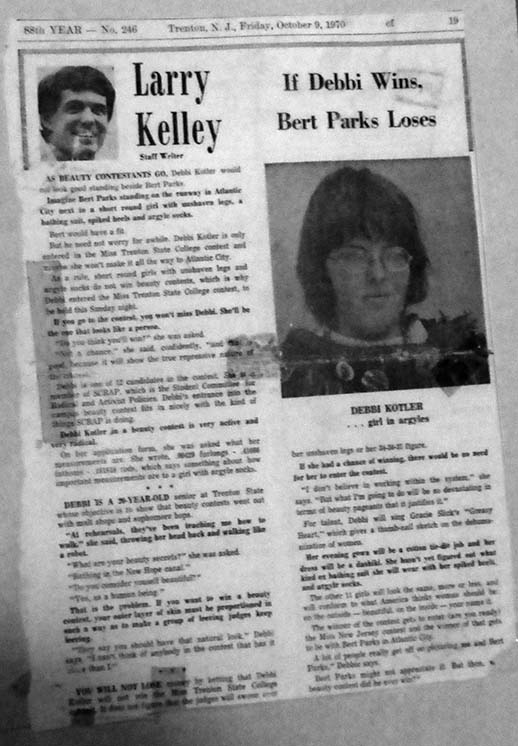
But not before I did my first really big feminist activity. That was being the Trenton State contestant in the Miss Trenton State Beauty Pageant. I was a feminist. And perhaps we’ll show you some pictures later on, but you know the press loves a weirdo. They love to get a hook into something that’s unusual. So I was the darling of the Trenton press for probably a good month before the actual show happened. The place typically would hold maybe a thousand, eleven hundred, and there were over 3500 people that showed up for that particular event. Pretty much all the radicals in the tri-state area. But I had odd support: the animal fraternity were cheering for me. The president, the dean, and the vice president all came to me behind the stage and threatened to have me arrested if I even thought about inciting a riot. I told them I had no intention of doing such a horrible thing. I wanted to have a good time. They still didn’t really believe me, and the place was filling up.
One of the girls pushed me out in front of the curtain when they were threatening to close it down because there were no fire aisles. I’m standing in front of the curtain at this point now, and there’s this mob out in front of there, standing up and clapping for me. I went silent, and I just like…they pushed me again: “You fix this, you started it!” So I started to try to finagle my radical group. It was called SCRAP, Students’ Committees for Radical and Activist Politics. I was one of two or three leaders of the non-group, and I asked them to be marshals. They went and tried to get people seated and did the best that they could. (Of course, when we had closed down the school about four months before, there was never an issue about fire aisles at those events, and we reminded them of that, too.) Ironically, I didn’t win, but the next morning when you see the papers, I’m on the front page. And it says, “For winner, see page 2”—so, who won? And my politics were in the paper day in and day out, and of course—
RN: School paper or…
FS: Dailies, all the dailies. Every kind of paper around was full of me [laughter]. They didn’t necessarily appreciate what I was saying always, but they knew it was controversial. And I knew how to work it. So I would call those my beginning stirrings of radical politics.
RN: So, getting you from New Jersey, where you grew up, and to Gainesville, that was in 1975, you moved to Gainesville—
FS: Well, to Melrose. We never moved to Gainesville. Because after living in New York City for five years and being in and out of it my whole life, I had enough city.
In New York City
“You must be Flash!” and that was a good guess because I was dressed pretty wildly with purple sparkle shoes and purple lamé scarf and just rainbow suspenders and tails.
RN: OK, so tell how you decided to move from New York City to Melrose (in the mid-1970s).
FS: OK. Well, I was working at Bonnie and Clyde’s lesbian bar in New York City, Greenwich Village. I was reading Tarot cards and playing music. How life has changed! And Corky [Kathleen Culver] came in. Yes, she was called Corky then, too. She came and she said, “You must be Flash!” and that was a good guess because I was dressed pretty wildly with purple sparkle shoes and purple lamé scarf and just rainbow suspenders and tails. It was a good guess! I was probably the weirdest-looking one there. And she says, “I hear you’re the best Tarot card reader there is. So I came up from Florida. I want you to do a reading for me.” I said, “Well, sure!” I was going to sit down there with her, but I think she decided that we would have a better time of it if we went to where she was staying, and a more peaceful situation. So that’s what we did.
Not long after, the conversation shifted to Melrose [Florida]. And she said, “You should see Melrose: it’s gorgeous! There’s all these wild women and white sand beaches, and orange trees and horses.” Horses! She had my attention. “And cows and mushrooms growing everywhere.” She had my attention even more! And first thing out of my mouth, “I’m not ready to move there!” She said, “Who the hell asked you to move? I’m just saying come visit!” But some part of me already knew the die was cast. And we came. Pandora and I came down for two weeks, we thought, stayed a month, and then we went back, deciding that we would absolutely move here. It took a year, a lot of cards to be read to afford a van (didn’t need one in New York), and we hauled all our stuff down and happily moved.
We were in the Red House for a while, and then someone else’s house. [For many years, Corky rented a big old Victorian house on 500 acres, and she sublet rooms to many women.] Everyone knew it as the Red House, and visitors or touring women musicians often stayed there. We finally moved into Hawthorne, which is the next town over, and just loved it! I mean, we definitely felt—like we didn’t exactly fit in for about the first year, because there was just culture shock on all sides. But we hung in there, and we really felt like we had—I had just been initiated by Z Budapest in New York before we came. All this stuff happened right before we left. We were very, very good friends with Kay Gardner, and we used to play at her house all the time. There was an initiation by Z, and the next day we had a combination wedding and going away party. Then we were on the road. Then we were here, and we were, you know, making our way. The entire first year, we toured a lot, up and down the coast, playing music and clubs, and getting the rest of our stuff.
Medusa Muzic
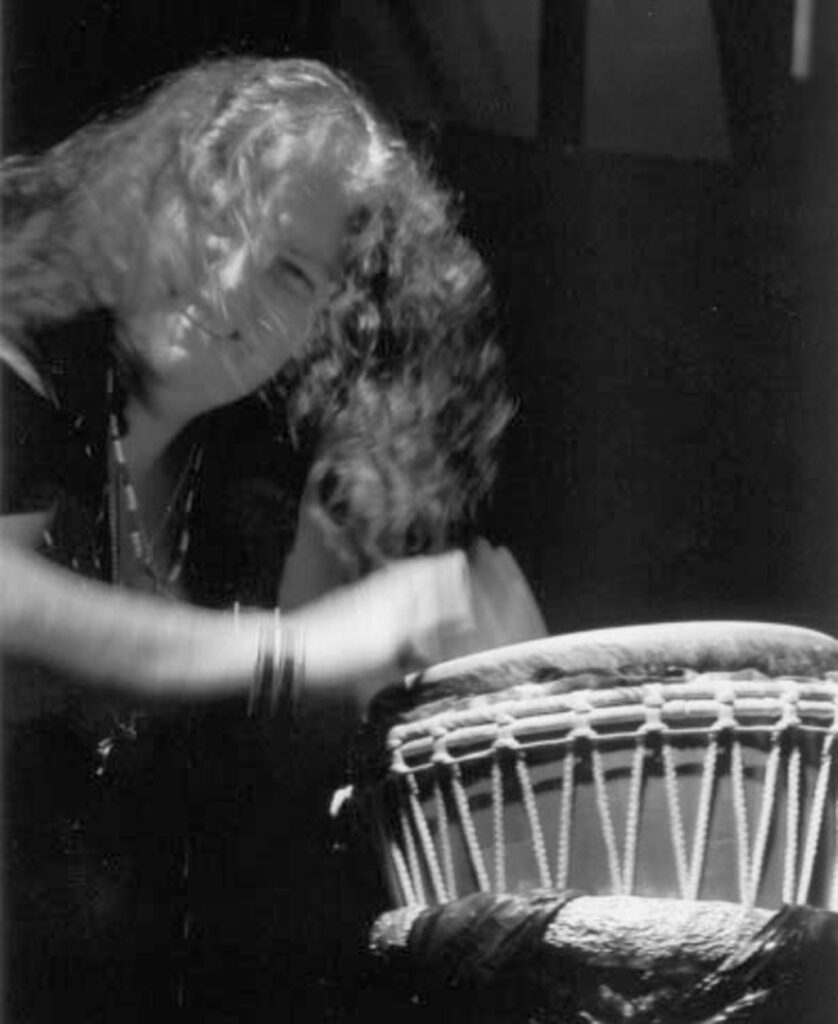
RN: Was that Medusa?
FS: Yes, that was Medusa Muzic. [This band consisted of Flash and Pandora and lasted until 1981.] We played, and I played, all the first Gay Pride things in New York, and all the first women’s dances there. So we just continued all in that line when we got down here. Styles here were more country; our styles were more rock and blues and R&B, stuff like that. It was difficult for a while. People thought we were just too strange and too political. At the time when we moved to—
Pandora Lightmoon: And too witchy.
Feminist Spirituality
FS: Well, certainly too witchy! Sometimes I’m just too easy about things, and I presume if I like something that everybody’s going to like it, and that everyone was going to be so interested in this new spiritual path that we were bringing down. We were excited because I had been working with this for some years, but now I was finally getting initiated, and there was a spirituality movement that there had never been. Z had been crossing the country raising awareness about that, and we met at just the right moment. We were part of her groups, but we came here to start our own as well. And it wasn’t popular!
RN: I know that Corky Culver, when I interviewed her, talked about doing various spiritual circles. Several people I talked to here, like Kate Ellison, were into spirituality. I don’t have the dates clear right now. So there were no witchy circles here until you came?
FS: No, nothing. Absolutely nothing. Some people came to our first one, a Halloween Circle in ’75, and we were so off the hook that we were doing skyclad [nude] ritual at our place, which was perfectly safe to do. But no one here had heard of doing such things. So there was much talk, and we didn’t want alcohol there, and no one had heard about doing that either. [Laughter] No alcohol, no cigarettes, and you know, we were starting to sound like real hard asses, which we really weren’t. We just didn’t want that kind of energy around. Within a year, I think we all kind of worked our way towards more of an understanding.
RN: You’re still at the Red House, then—are you doing—
FS: No, that was not at the Red House. We had our own place in Hawthorne by then.
RN: OK, so did you start doing the circles while you’re in Hawthorne?
FS: Yes, that was the first time we had our own place. There’s a thing called the Florida Feminist Festival, and we had played for some big women’s spirituality gatherings in New York and in Boston [Massachusetts]. Actually, the first two that happened. Kay Gardner came back down with us to do the Florida Feminist Festival. That was in St. Petersburg [Florida]. I think that must have been October or early November, I’m thinking in 1976. Because we had just been up and played a Halloween gig in New York, and she was there with us, too. So we all just got on the turnpike and went. The Florida Feminist Festival was a big thing. She and I co-facilitated the women’s spirituality teaching there. She told us it took a long time to get there. So we’re thinking, we’re doing fine, we’re hauling our butts down to St. Pete, and Kay is trying to spend some time while she’s waiting for us to come, because she told us an hour too late. Meanwhile, she’s telling everybody that I’m a genius and we’re just the best thing since sliced bread, and blah blah blah. We walk in the room, and we get a standing ovation. Now we’re looking at each other, and we’re thinking that we couldn’t even get arrested before this. [Laughter] Which didn’t stop us from getting arrested before this. But she just, you know, we were everybody’s best friend after that. She said, “They’re OK!” and everybody said, “OK, then!” And things went a lot smoother after that.
I was teaching Tarot, just from the time I got here on.
I guess the next really major thing was our political activities. Women were being raped, and we had a protocol for rebalancing women psychically after rape, doing a circle and a bath, and some rituals for them to get the fight out, and it was quite good. It’s something that Z had written up. We did a bunch of those ceremonies for women, especially some women who were working with battered women’s shelters.
RN: Who did you work with at the battered women’s shelters?
FS: It was, goodness…
FS: Yeah, I did stuff with SPARC. I actually did something with the woman, and I probably didn’t name names, but there was someone who had worked in Jacksonville [Florida] as a key person, getting one of those facilities together, and she had been raped. It was interesting because a lot of people wanted her services, but they also wanted to be very secretive about it. They didn’t want to be seen as people who like witches. So we went ahead and did it anyway. And pretty soon it was a little more out of the closet. And we did a bunch of ceremonies like that to help women who’d been raped.
[Flash may mean Ellen Spangler, who was instrumental in founding the battered women’s shelter in Jacksonville, Florida. She had been battered by her husband. Ellen had attended the first women’s spirituality conference in the United States, “Through the Looking Glass,” held in Boston, Massachusetts, in April 1976, at which Flash mentions performing, along with Kay Gardner. ]
Woman Spirit Rising
There were lots of feminist activities that went on through there, where we were active. And we walked into the university where all the fraternities were, because someone had been gang-raped there, and I helped facilitate that as well. We both facilitated the first “Take Back the Night” here in town. It was a Mercury retrograde, and I told everybody that, and I said, “I know a lot of you think this is crap, but let me just put it out there: that whoever is going to be in charge of the nuts and bolts of where we’re going to be and everything, double-triple-quadruple check, because you’re going to need to.” What wound up happening is that the date we were supposed to be on that stage at the downtown plaza, they’d already scheduled it for the Navy Band. Everything that could have gone wrong went wrong. But we managed anyway. I think we started an hour later, because we had to not be in their way. It wasn’t great, what all happened, but it still was wonderful and was the first.
A load of women came out for it, some moving through different other assorted events to Woman Spirit Rising. Woman Spirit Rising was the first gathering of women from all different spiritual paths. I knew I was going to be representing the witchy part of the group, and Georg [sic] Suzuki represented the Native American path, and—
RN: A man?
FS: No. I don’t circle with men.
RN: Then, Georg Suzuki is a woman?
FS: That’s her name, yes. And Bahira Sugarman represented kind of the New Age and Jewish folk, and I knew that I had to have an African priestess. I didn’t know any. I knew I didn’t just need a Black woman who was spiritual, but I needed a real African priestess. I mentioned that to someone, and she guided me towards a woman who had just come in—there had been, I don’t think, hardly any African priests and priestesses in town until about two months before this event. And I wound up hooking up with Ayoka.
We were the four priestesses for the first one [Bahira Sugarman, Georg Suzuki, Ayoka, and Flash]. It was so wonderful that I became involved with the African families here in town, as part of the family. We still do things all together. But that was the beginning of that connection, which was really very rich for me. I had hoped for maybe 100, maybe 200 if we were really lucky. And there were over 350 women there, that showed up for this thing that had never happened before. The publicity [was minimal, no newspaper advertising]. We didn’t have fancy anything. There were no computers then. I made this small, very no-nothing on it, kind of flyer, black and white, no graphics, nothing. And I handed it to someone and said, “Listen, now make ten more, and tell everyone who takes one to make ten more.” We just had a very grassroots way of coming together.
When I got over there, typically whenever you do an event, you’re usually waiting for the folks to show up. We did a little beginning ceremony with all the priestesses, just to warm up, and when we got to the parking lot a half hour early, there were no places to park! Oh, I neglected to say, the reason that I did this was I was awakened in the middle of the night by a deep female voice, waking me up saying, “Flash, you have to gather the women.” I said, “All right, I’ll do that in the morning.” “No, now!” “Ah…all right.” And I pulled myself together, got up, took out the ephemeris, and I figured out, OK, here’s the date. I looked astrologically for a date that would bring the outer planets and the moon together on a full moon, found the date, then by dawn I knew all the people I needed to contact. And by 8 in the morning I had my major people together, except for an African priestess.
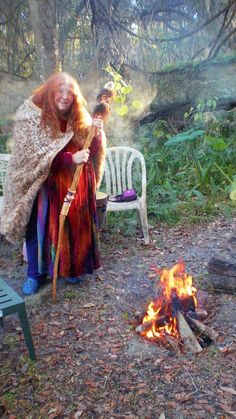
RN: And what was the date?
FS: I’m pretty sure it was July 9, 1990. Even the sheriff, the woman who’s sheriff now, Sadie Darnell, was there. The Hari Krishnas showed up, and at the last minute they said, “We want to have time in the circle, too.” I said, “You’re just getting in touch with me, and you really have a patriarchal religion, and that’s not the kind of religions that we’re trying to show here. However, as we leave the circle, if you’d like to sing ‘Hari Krishna,’ have at it.” I didn’t want to, you know, shut anybody up who was sincere, but I also didn’t want to glorify gods in our circle. And we didn’t. Because I’m really down on patriarchal religion. I’m not religious, I’m spiritual. So we had, I think, four more of those, within the next two, two and a half years.
I should have started to get the idea that as I was doing all this multicultural stuff, that there was a name for the kind of spirituality that I had. But I hadn’t figured it out yet. And I should have figured it out, because I’m doing this Tarot deck, The Wise Woman’s Tarot, which is all about the Goddess culture from all around the world, both the ones that we know and the ones that we don’t know. And there’s a few gods mixed in there; some are pre-patriarchal and some are the nasty dudes that we love so well. But mostly it’s all Goddesses. I should have figured out that this whole business of global was really important to me, that there was a thread. I hadn’t figured out yet that I was on this path, and it took another eight years of doing the Wise Woman festivals, eight years of those, and when it was all over I said, “Oh! My spiritual path is the Rainbow Goddess tradition, because I don’t just like white European deities, I like them all.”
A lot of women’s spirituality in the United States is pretty much Celtic, white spirituality. Of course, there’s Native American, and there’s Yoruba, which is the Nigerian part of Africa, and so many different views that one could have, that all have, to me, something very good. Clearly, I was on that train of ideology, I just didn’t know how to name it yet. But it really has brought a lot of joy to a lot of people, a lot of understanding. Some of the young women who would come to Wise Woman were just, like, “I can’t believe I can just put my purse down anywhere and nobody takes it. Nobody messes with my stuff!” They were just flabbergasted that they could do that.
RN: When were these Wise Woman festivals? This is not the same as the Woman Spirit Rising?
FS: No, Woman Spirit Rising was in the ‘90s; Wise Woman festivals started on Sept 25, 2003, I believe it was. And went until April 8, 2010, right?
PL: Yes, the 8th to the 10th, that’s right. I’m pretty sure that’s right.
The Wise Woman’s Tarot
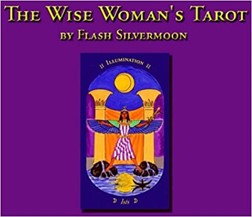
FS: But The Wise Woman’s Tarot was this little project that took me a good long time. I didn’t intend to make a whole new deck. I was basically just going to do a really good “how-to,” because my students kept saying, “You have to write a book. You make it easy for us. I don’t know any other place where I get such an easy way in to the understanding of the Tarot.” So that’s what I started doing. I wrote and I wrote and I wrote, probably a good two or three years about that.
There was this renegade page called “Visions of a New Deck.” It was only supposed to be visions, but, you know, you give some kind of Tarot card a little spot and it wants to take the whole book! And that’s exactly what happened—visions for the new deck became a new deck. It just became clear that’s what I had to do. I don’t think anybody has done a deck like mine, because there’s such a deep reverence for the ancient wisdom of the Tarot. I did not arbitrarily make changes; I didn’t just try to put out a feminist version of the Tarot, as has been done. I really wanted something that, at its core, really held the archaic, good parts of the Tarot, the real ancient knowledge. And to give it a real update in terms of removing the racism—you didn’t have to add feminism, it was already there.
It’s through lack of understanding, really, that people needed to think they had to change it up that way. It was there; they just didn’t understand it. I studied, of all people, Alistair Crowley, who was such a woman hater. When you look at the woman haters, you look at what they don’t like and then pursue that, because usually what they don’t like is what’s really good. It’s what they are afraid of. So you want to poke around in that mess until you discover what they have to say. He was giving certain clues about it—I mean, I changed the whole order.
RN: I noticed that. What was that about?
FS: Well, the Tarot is really, it’s got its own story. The first part, the major arcana, is about the descent of Spirit into matter; that’s how it begins. It’s supposed to be a single gender for that, because in the metaphysics of the ancient ways, we were still a single-sex being when the Tarot was founded. Then, when we shifted into being two different sexes, a different level of consciousness was manifesting. So we had male and female at that point. That’s part of what the Lovers card is actually about, about the time before we could go in and out of body freely. That was one of the reasons that I started the process of the artwork with that card, to see if she could get it.
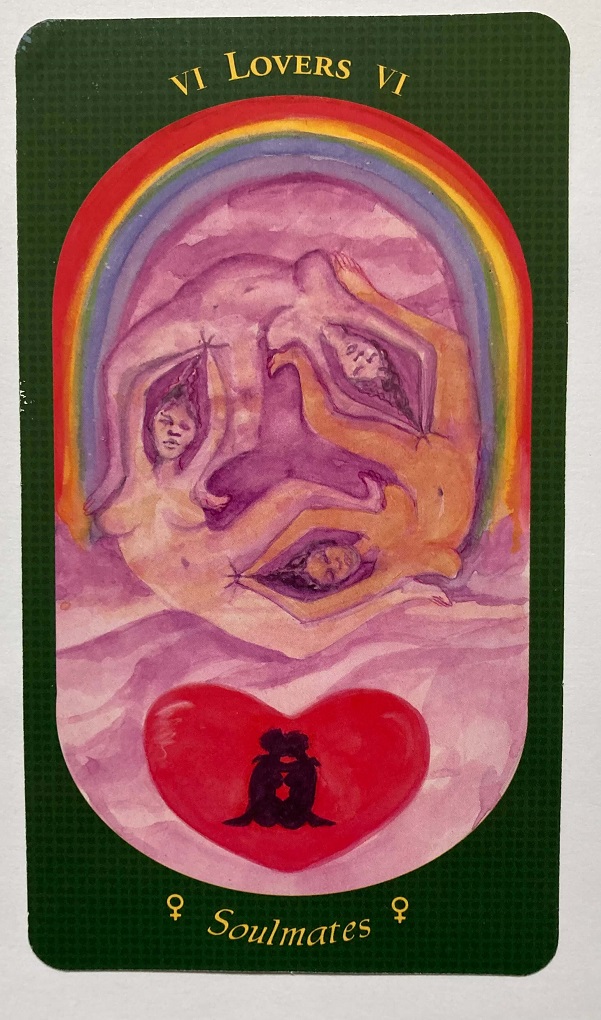
RN: Oh, tell about meeting Barbara Vogel.
FS: Yes! Barbara Vogel was the illustrator for The Wise Woman’s Tarot deck. She was an old friend from New York City, and she just showed up one day in Melrose, and then lived with me for a while, and then traveled away and came back for Corky’s croning. Corky’s a very key person here in this picture, because she was here for Corky’s croning, came to visit my new place, sat under the pyramid in the yard, and got a total inspiration that it was time for her to do art again. As she said those words, I had been looking high and low for the right artist, and I had seen a bunch of different artists’ work, and none of it was hitting me right. I knew that even though I was an artist myself, mine wasn’t the right art. I heard her say those words: “I want to reconnect with my art,” and a lightning bolt went off over my head. I said, “Vogel! Would you like to do the artwork for The Wise Woman’s Tarot?” She smiled, and she just lit up, and said, “I think I might!” At which point we talked about it in detail, and I said, “Why don’t you just do one card and let’s see if we’re both cool with what’s happening?” And she did one card, the Lovers card, very quickly, got it back to me—I loved it! And the entire process of her converting my notes and research and designs into a deck—I think it took about three years, four years maybe. And the whole time, I’d send her the notes and everything, and some were quicker than others, and she’d send me pictures after a while, only maybe two or three.
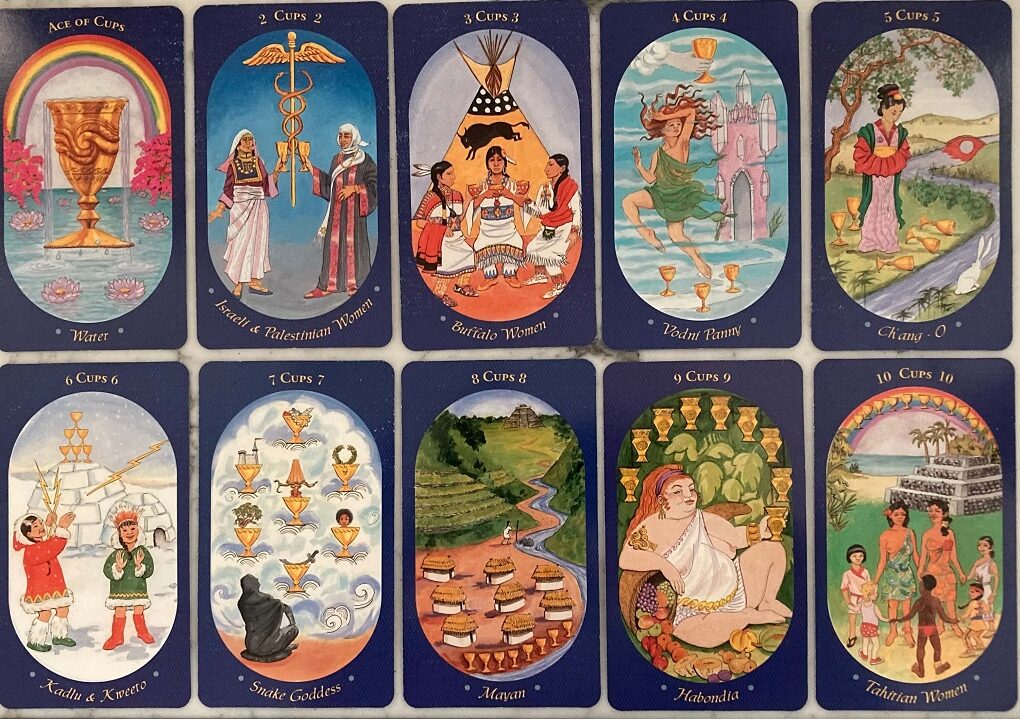
RN: Was she still in New York?
FS: No, she was in Florida, down by the Keys. She was living at Sugarloaf, in the community there. The project really kicked off her whole artwork again. She also got sober doing this deck. That’s no secret, it’s right in the book. That’s something she was very comfortable letting people know. It was a good collaboration! There were only two or three times when I would see a picture and say, “Ummmm, something’s not right here.” Mostly she got it, and the only conversation we had with some consistency, was that I always wanted bolder colors. She didn’t always do them as bold as I wanted, so she would make them better. There are a few that she said, “Now I know you like bold, but you know what? These have to stay more pastel-ish.” I said, “OK, you’re right!” [Laughter] And so it went. So it was pretty smooth, that whole part of it. I was very very pleased to see art that matched the potency of the writing. A lot of decks you’ll see nice images, but the text is so-so. Or vice versa, you know, really brilliant text, and then the visuals aren’t so much. I really wanted mine to be good both ways, and I think between the two of us we got something good.
RN: It took how long, from when to when?
FS: Twenty-five years! [Laughter] I wouldn’t call myself a perfectionist, but I do have a deep desire to not mess with magic, to try to bring the best I can out of it. And all the while my music was sitting over here, and I was just dying to get back to the studio. I had done one CD already, and I was so dying—this project was twenty-five years and I knew I couldn’t just jump out and do something else major until it was complete. So twenty-five years for The Wise Woman’s Tarot, and two weeks mainly, maybe ten days to two weeks for my second CD. [Laughter] I was done!
I was done with The Wise Woman’s Tarot on Halloween, and then of course there were some other things to be done with it after it came out, and in February I started my second CD. I was done with it in two weeks. It’s like I was really ready to bust into something that was not so heavy.
RN: Tell me the title of that second CD.
FS: That one’s called Phases of the Silvermoon. I wrote all the music, arranged it, and performed almost all the tracks. I sang, and Omi, who’s one of the African priestesses that I’ve worked with, she does some backup singing. Denise Burnsed, who just came over today, she played bass and did some backup singing on there, too. Together, the three of us are called the Blues Sisters. And now Pandora’s in the Blues Sisters as well. Sometimes we’ll have another woman musician come in who’s around the neighborhood, and she becomes one of the Blues Sisters, too. It’s usually the three of us.
RN: Say those names again. You and the two…
FS: Omialadora Ajamu, Denise Burnsed.
PL: Do you want to mention Tara Allen and The Wise Woman’s Tarot?
FS: Yeah. Tara was the woman who published it, The Wise Woman’s Tarot. Last name Allen. And sadly, I’m the only one alive of the three of us.
RN: You mean Vogel is dead too?
FS: [Long Silence] Um…
RN: And you were partners with Tara at that time?
FS: Yes. We were together for about eight years. [Another long silence]
RN: What about your first CD; when did you do it?
FS: First CD I did in December ’89.
RN: This other one would be 1999, or 2000 I guess?
FS: Yes, 2003.
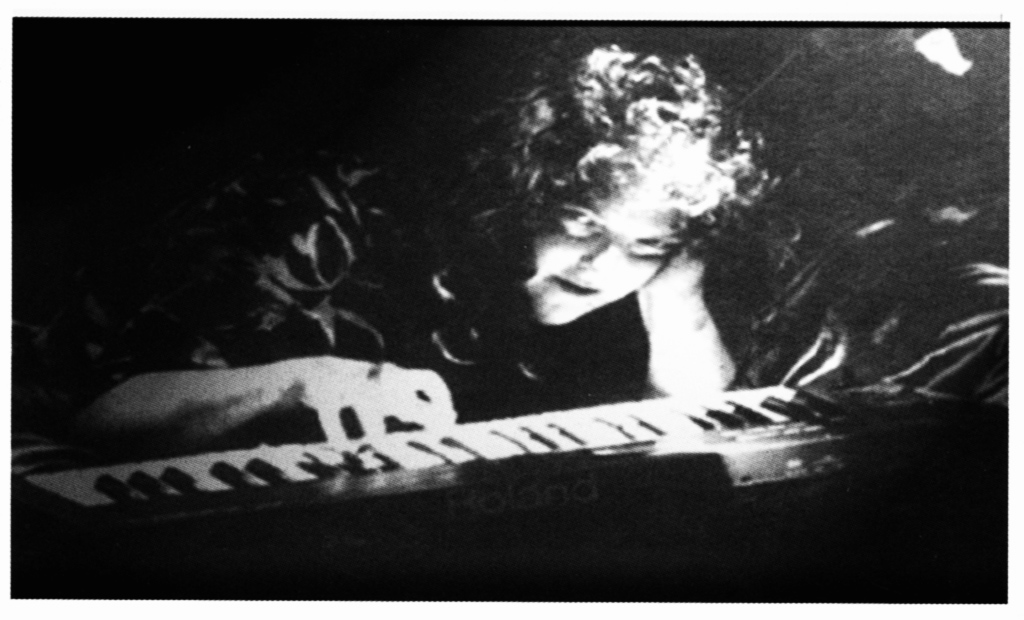
RN: 1989…so that’s more in our period. Tell me about the first CD.
FS: First CD. Well, I had been dying to get a really good recording, and I did it in several parts. You know, money and such, and working different studios. Both my CDs are a real mixture. On both I wrote all the songs, sang them and played almost all the tracks. Makes it a little easier that way, and makes me work faster, too. It’s a mix of blues, and rock, jazz, funk and world beat. It’s kind of like that combination in both of them. I didn’t plan it that way, but when I kind of look over the situation, what I see is, I like a mix. I like a blend of different things. So if you don’t like one song . . . There’s even sort of a country-ish song on the first one, which is not my thing but I wrote this song called, “What Do You Do When the Song Outlasts the Love?” I had opened up my guitar case, and all these old songs came flying out. I said, well, what do you do when the song outlasts the love? You know, you can’t sing this one. You make a song about all of them. And then you’re done with it! And that’s what I did with that. I wrote one song on that CD for the Harmonic Convergence called “Dream the Dream of Freedom.” It’s got a really nice Afro-Cuban beat to it. I use that one a whole lot, still. It’s one of the songs that I just never stop playing. I do that one at a lot of festivals and particularly political rallies. “Every one of us dreams a dream of freedom; every one of us has a little light, a little light that shines.” That’s kind of the beginning to it. “And everyone around the world dreams a dream of freedom; gather now and dream the dream of peace alive.” It’s nice and fast and rhythmic, and lots of times circle dances will start in the middle of the events, which is exactly what I love to see. Of everything I do, I get the biggest response for the blues; I have a natural feel for it.
Psychic Connection to Janis Joplin
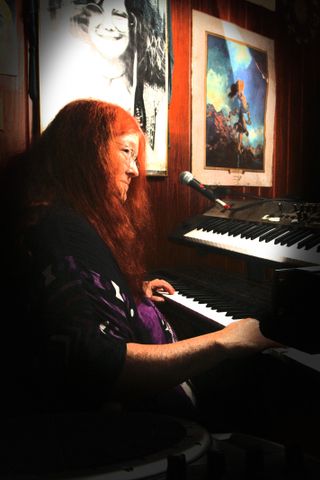
I’ve neglected to mention this, but I should tell you that the musician and the spirit that brought me full bore into my psychic world was Janis Joplin. I don’t tell people a lot about this, just because when you say someone famous, they think, ah yeah, you’re just making it up. But a few weeks after she died, she came to me. It was right after Pearl was released [her last album]. I got this vision just [snapping fingers] just that. There wasn’t much to it, but the message was very clear. I saw her bloody face, and she wanted everybody to know that she did not kill herself. She did definitely die of an OD, no question about that. But it was not self-inflicted.
Finally, last year [2011], I would up writing a whole book about it called Janis Joplin and Me: Forty Years of Music and Magic. She’s been a thread in my life, even while she was alive, too. I really loved her, and actually met her and had a drink with her once. But the thread of her has woven itself through my life, too. Finally, after forty years, I realized that I needed to tell this story. I wasn’t telling it because I was twenty years old [when I met her]. Who would listen to a twenty-year-old? I really believed then, and I believe even stronger now, that there was literally a conspiracy to wipe out the culture of the late 60s and early 70s. Just like Chairman Mao did that revolution in China and wiped out the culture there.
I believe that there was a desire to—I mean they did the Kennedys and Martin and everybody. They killed so many political people who were our healers, our heroes. And then they took out the fabulous musicians. They singlehandedly wiped out the fabulous revolutionary culture of the day. We have not had musicians or leadership like that since. I write about that a bit in the book. It’s an e-book, and anything from my cards to my e-book and CDs, they can get that on my website, flashsilvermoon.com . [This site is still active, though not for e-commerce.] But it was funny, because she has been coming through me for years. And this is not just some—
PL: You can hear it when she [Flash] sings the blues.
FS: Yeah. It’s not just some high-handed idea that I think is kind of cool, but people who don’t even know this story will come in and say, “I saw Janis over there!” Some young boys who were doing my yard came in and looked at this picture here [gesturing to the poster of Janis Joplin on the wall], and said, “Was that you when you were younger?” I said, “You don’t know who that is?” (Laughter) “No, that was not me when I was younger!” People think that I look like her—I don’t look like her, not really. But there’s a vibration, and a lot of people just get that. There’s something that people do pick up.
When I was writing this [Janis Joplin and Me], she surprised me even more as I was writing away and remembering all these stories of things that happened and things that I learned, and what-not, just crazy wild stories of my well-spent youth, and my interactions with her spirit. I got to a point when I was just thinking, what do I write now? And I heard her in my head say, “Yep. That was around the time I met the first woman that really meant something to me.” I stood straight up, because I hadn’t heard anything that clear from her in years. I just figured I was going to be writing my memories. No! I was getting a whole new batch of stuff. I thought, “Now what do I do with this?” and answered myself, “Well, I just start to include it.”
So I was just going as fast as I possibly could to catch all the information from her that she was giving. Then she told me this whole kind of nasty business, about her family, and she went on and on, and we had never set up rules, like “Write this, not that.” So what wound up happening is that everything that I wrote about the whole family deal, she disappeared it. Just flat-out disappeared it. I was really pissed and freaked and annoyed. I said, “Why?” And then I realized, oh, this wasn’t supposed to be in the book! So everything I wrote after that, I doubled and made sure it couldn’t go anywhere. I sent it out to three different people to hold on to it so it couldn’t disappear. But she kept saying, “Use me. I want you to use me. You get on there. You tell my story, and allow me to help you.” So that’s been a very long thread.
PL: During those years, she saved our lives. She saved our life when we were here one time—
FS: At least three times when we were in New York. I’ll try to encapsulate it. We were sleeping, and we had had a rough night. We had been fighting, and she was fast asleep, and I was still wringing my hands. You know, in a couple, there’s always someone who will fall asleep during anything? And there’s usually the other one who’s like [gasping indrawn breath sound]. Well, that’s the one I am. So in the middle of the night, it’s like 4 am, and I heard a rustling. And this was where she usually came to see me. It pulled me out of the almost-sleep. “Oh, it’s only Janis.” “Only Janis! Whoa! I’ve got to get up for that!” As I did, I could smell smoke. It was really, really thick, and I said, “Hey! You smell anything?” “Oranges and grapefruits.” I said, “Oh, never mind.” I got up out of bed, and I walked all around looking for cigarette butts somewhere, and it turned out there was a huge fire somewhere in the building. I got up, and we got everybody out of the building. We were up five flights in Spanish Harlem, and we got down to the street and called the cops because I was too poor for a phone. The cops got right over, and they said, “Well, whoever called us saved everybody’s lives. That boiler down there is about to burst.” If it hadn’t been for her getting me out of that almost sleep, we’d have all been done.
There’s two other occasions, but that was really the strongest one. Another one, while we’re here, was when we were picking up someone at the airport and about to cross the road, and her music came on. That slowed us just enough to go, “Oh wow, there’s Janis on the radio.” And boom, right in front of us this old couple were killed instantly by a fast-moving car. We were right behind them. So that’s…I’m very grateful for her intercession in different points of my life.
She actually helped bring us together, because she [Pandora] was singing the song that Janis was singing the first time I ever heard her have anything to say, when I got that first message from her. I was working at the Women’s Center, the first time she [Pandora] came over, and she’s singing that song going up the stairs. I immediately got up and went over to her, like a crazy person, not at all thinking she’s going to think I’m weird. I didn’t care. I was just so shocked. I said, “Why are you singing that song?” (gruff voice) And she says, “I don’t know…”
RN: What was the song?
FS: [Singing] “Cry Baby.” That one. Not a good use of my vocals… [clears throat] We immediately started talking. I knew that there was something I was supposed to get from this woman.
[The interview continues briefly on a second recording, adding information about Flash’s work as an astrologer and psychic.]
PL: [Flash is] recognized as the premier psychic in this region, Florida, and further, really.
FS: And the out-est astrologer [laughter].
RN: It’s interesting that you did mention Tarot several times—I mean, obviously because you wanted to talk about the deck—but you know, when you met Corky at the bar. I don’t think you mentioned the psychic work then.
FS: Well, I mean, that’s what the Tarot readings, that is…
RN: Oh, OK. So you do psychic readings apart from the Tarot readings?
FS: Both. My psychic readings are—I use Tarot to do them. But like when I do readings on the radio—I didn’t mention that either—I’ve got three radio shows. I started doing just a lot more out there.
RN: Well, you wanted to talk about the animals, so go ahead.
FS: Yes. I’ve always adored animals. They are just such a huge part of my life. I’ve always worked with them one way or another, but about twenty-five years or so ago I decided to become an animal communicator. Some people call them pet psychics, dog whisperers, whatever. But animal communicator and vibrational healer is the work that I do. I started working with my own pets and learning how to treat them and do better with them than the vets could. That fanned out to working in sanctuaries, so I’ve been working a lot with tigers and lions, bears.
PL: [Dog barking throughout last segment] Does she know that you’re talking about animals? [“she” is the barking dog.]
FS: Yes, yes she does! And chimps. One of the Sanctuaries is called Earsinc.net. That’s where the big cats are. I just love them. I’ve got some very deep connections with those cats, and with the bears, and some of the primates there as well. I also do work at JungleFriends.org and their primate sanctuary, and a whole bunch of other sanctuaries. I’ve been wanting to work with the elephants. That just hasn’t happened yet.
PL: And your mystery school.
FS: Yeah, I have Moonhaven Mystery School of Earth Magic for Women. A lot of people think that these animals are just mean and vicious, and nobody who runs a sanctuary wants those animals anywhere but in the wild, where they’re supposed to be. The exotics are not supposed to be in our living rooms, especially the primates. It’s a horrible thing, the primate trade, and what happens to them. So there’s always a lot of work to be done on these animals that come, because mostly they’ve been in some way abandoned, abused, neglected, sometimes left for dead. I can’t fathom someone having a tiger and not just being so in love with it that they wouldn’t do their very best.
But these are animals. They don’t make good pets. They’re not for that! But I’ve got very loving relationships with many of them, and one whose life I saved. My parents were just amazed when they visited one time, because I walked down the road at his place, and he rolled over on his back and he just laid down as soon as I came over. He was licking my hands and rubbing up against the enclosure. They said, “He remembers you!” And I said, “Of course he does. I saved his life. He knows it!” I’ve known some of these cats, I’ve held them when they were just baby-sized and fed them a bottle. Whoever could imagine doing that later in life? It’s made my work as a psychic and an astrologer for people, in some ways, bearable. I mean, I love the work that I do; I love ALL the work that I do. But having the refreshing energy of animals has been a real boost for me.
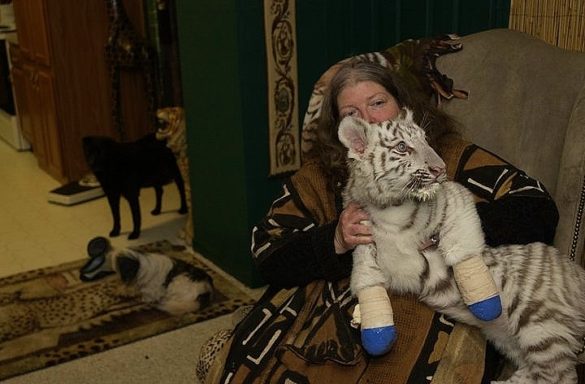
Sometimes, early on in the work, people want you to be a fortune-teller. Ugh! No thank you! When I reached my Saturn return in that work, I said, “OK, Goddess, please. I don’t care if I have to take a pay cut, but bring me the growers. Bring me the ones that want to use the best of what I have to offer, and really change their lives, transform themselves, rather than, ask ‘Oh, when’s my girlfriend coming back? She took all my money and she took my car. Is she coming back?’ NO!” [Laughter] “And you damn well better not let her in the door if she does!” So I’ve certainly been through my times about rage working with people, which I never experienced with the animals. But I love doing psychic work. I love doing astrology and past-life regression, and stone work. I do a bunch of stuff, and I love all of it. I love that I do not work for the system, and haven’t, really, my entire life. It wouldn’t have worked very well. I’m not suited for it, and fortunately, I understood that. And that’s happy! Happy Moon, who recently ran for president! She ran for president because she thought, you know, things were just wrong. Anybody who would tie their dog to a car had got to be crazy, and no one should ever vote for that. So she said, “I’ve got to step up!”
RN: That was mean!
FS: That’s right! She was one, and she took everything in her own paws [Couldn’t hear this].
PL: She’s the politico too.
FS: She is! And she had a campaign going on one of the radio shows I do called “What the Animals Tell Me.” That one I’ve done three years or so. That’s my main show, to give them a voice, and help people who love them understand them better. There’s another show that I’ve been doing just for a few months now called “Woman Spirit Rising.” It’s a live show where I work with four or five other priestesses, and we’ll take on a circle. We’ll do it live on the air so others can learn how to do what we do. Those that have already practiced can have a place to come, a safe place to exercise their spiritual muscle. That’s actually tomorrow night. Tomorrow night is going to be psychic self-defense.
This interview has been edited for archiving by the interviewer and interviewee, close to the time of the interview. More recently, it has been edited and updated for posting on this website. Original interviews are archived at the Sallie Bingham Center for Women’s History and Culture in the David M. Rubenstein Rare Book and Manuscript Library at Duke University in Durham, North Carolina.
Do you have something you’d like to add to this tribute?
Take the leap and share the lesbian love.
Or you could write a few lines in tribute to another lesbian.
Just contact SLFA.
